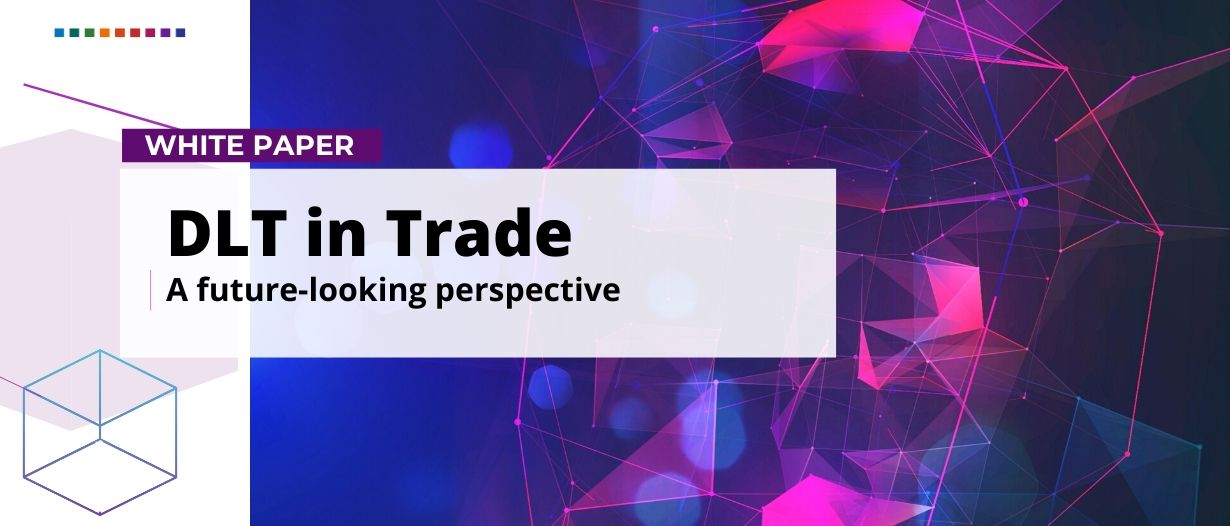In this analysis of the TFG and WTO survey results, industry leaders provide their views on what the future of the DLT in trade industry will look like.
With opportunities in mind and challenges addressed, we are free to look ahead to what the experts believe the future of the industry has in store. According to our survey the trade industry will see a gradual evolution, not a revolution leading to a web of connected ecosystems and consortia models that drive collective value.
Evolution not a revolution
In discussing how the DLT in trade landscape would alter in the years to come, many experts point to the idea that change will come rather slowly at first. “The change curve is expected to have an exponential shape, so a slow start, a turning point and a steep end” (Hans J. Huber, ICC DSI). This is due to the fact that, in the trade space, many of the changes that need to be made “will take time and effects are often interrelated in a limitational manner” (Hans J. Huber, ICC DSI). Changes as wide reaching as eliminating siloed systems, displacing paper-based administration, digitizing consumer and service provider processes, addressing legal and jurisdictional concerns are limited to the progress made in each of the others. At some time in the future, a tipping point will be reached in the development of each, reducing the restrictional interrelatedness and allowing much more rapid progression to occur. While it is difficult to determine precisely how sharo the uprise will be, or when it will occur, the ICC DSI expects “the turning point to occur in the next 4-7 years, if concerted efforts are being started now.”
The future-looking results collected in our industry survey indicate a similar sentiment. When asked about their outlook for the widespread adoption of DLT within the trade finance space, only 42 percent indicated a positive outlook in five years time but that number jumps to 73 percent when the time horizon is expanded to ten years. Both the quantitative and qualitative results support the notion of a gradual DLT evolution.

“It will be an evolution, not a revolution”
Jacco de Jong, Global Head of Sales, Bolero International
A web of connected ecosystems
While several experts pointed to a future web of connected ecosystems, the vision of their exact composition varied. It seems likely that “Consortia and ecosystems will cohabit as isolated solutions to specific markets or industries” (Pierre Sien, Euler Hermes). Some form of interconnectedness between these cohabitating networks is a near standard claim, although the manner of interconnectedness varies. Relating to this realm, some experts believe that the industry “is likely to be technology-agnostic and that ecosystems and standards will evolve to be able to send and receive information to any platform across a shared set of protocols” (Daniel Wilson, Maersk GTD). Other views contain less technical interoperability optimism. Pierre Sien from Euler Hermes says that “new challenges will be in interconnecting those ecosystems. Trusted third parties will still exist and they will become central to ecosystems that look forward to opening to other ecosystems”. Whether technical interoperability challenges can be overcome, or trusted oracles will become a necessity for facilitating interconnectedness, it seems likely that in the future the DLT in trade space will consist of an ecosystem of interconnected networks.
“Trade Finance will hopefully be a web of connected, aligned, and value-creating ecosystems that allow existing customers of financing to receive better products at more competitive pricing”
-Daniel Wilson,Head of Strategy and Operations, Maersk GTD.

Value-Creating Governance Models
An aspect of the DLT environment that is often overlooked in the mainstream media, is the business models of the consortia that are forming, and how care must be taken when designing these to create value for all parties involved. Bringing a multitude of firms together into a consortium has the potential to create many positive benefits for the industry as a whole and for the individual participant firms well in excess of the consortia setup and maintenance costs. In order to ensure the continued strength of the consortia that currently exist, and to promote the creation of new, innovative consortia, certain considerations must be made. Most notably, these consortia must establish ways of ensuring that the collective benefits that are generated by this model are allocated in a fair and equitable way. According to cooperative game theory, developing and implementing a gains allocation model will provide participating organizations with financial clarity while simultaneously reducing the fear that other firms may be benefitting parasitically off their dedicated investments. This transparency will help to enhance the trust and stability that will encourage individual firm’s willingness to disclose sensitive information to other consortium members. This mutual divulgence of information will strengthen a consortium from the inside out, and drive an increase in commitment. Not operating in this cooperatively beneficial manner would leave a consortium weak, resentful, and vulnerable to secretive self-destruction.
Industry Outlook
An examination of the data collected by the TFG, ICC, and WTO survey on DLT in trade revealed some insights into the perceptions held about the future of the industry. First, there seems to be a collectively positive perception of the state of the industry at the 5-, 10-, 30-, and 50-year outlooks. The 10-year industry outlook holds the most positive sentiment with a modest decline then happening through the 30 and 50-year views. This seems to indicate that the state of the technology and its widespread adoption will grow over the next 10 years. Beyond this time frame, it seems as though the perception is that DLT’s prevalence in the industry will gradually decrease. Perhaps this will be in light of the development of newer technology that could render DLT obsolete. While these predictions do offer some insight, it is important to recognize the immense difficulty that exists in predicting what the next 50 years will hold.
It is also interesting to note the difference in perceptions of the technology over time between firms using or developing DLT and firms not using of developing DLT. At each of the four-time spans, firms not currently using or developing DLT have a statistically significantly lower perception of its widespread adoption in the future. There could be several varyinge\explanations for this. One possible explanation is that firms possessing a preconceived pessimistic outlook for the technology were less likely to have begun developing or using the technology. This would have created a naturally positive bias when segmenting out those firms that are using or developing. Another explanation could be that firms using or developing technology have a greater insight into the industry than those who are not actively involved. This would allow them to be more aware of the acute happenings in the field, such as when progress has been made to overcome a once insurmountable challenge. Insider knowledge of this sort could also be used to explain the statistical differences noted above.
Another insight can be gained when looking at the perceptions of challenges facing DLT between these firms types. Firms using or developing DLT perceive regulatory, compliance, and legal challenges, as well as technology challenges as having a significantly smaller magnitude. Similarly, amongst firms using or developing DLT, there is a slight negative correlation between the current state of development for that firm, and their perception of both regulatory and technology challenges. This means that the further along in the implementation stage a firm is, the less prominent they view the challenges of the industry. This could be because firms actively involved in the space are constantly aware of when an advancement has been made to overcome a past challenge and are thus better attuned to the exact current state of the industry. However, these same data, as they merely represent a gauge of perception, could be construed to mean that firms using or developing DLT are inherently subjected to a natural bias that is causing them to view these challenges through magnitude-mitigating rose-coloured glasses.
























